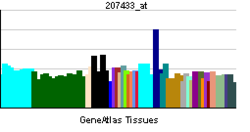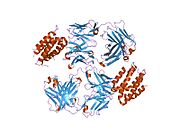Interleukin 10
| edit |
Interleukin 10 (IL-10 ili IL10), isto poznat kao ljudski inhibitorni faktor sinteze (CSIF), je antiinflamatorni citokin. Kod ljudi IL-10 kodiran IL10 genom.[1][2]
Ovaj citokin proizvode prvenstveno monociti i u manjoj meri limfociti. Ovaj citokin ima pleiotropske efekte u imunoregulaciji i inflamaciji. On umanjuje izražavanje Th1 citokina, MHC klas II antigena, i kostimulatornih molekula na makrofagama. On uvećava preživljavanje B ćelija, njihovu proliferaciju, i produkciju antitela. Ovaj citokin može da blokira NF-κB aktivnost, i on je uključen u regulaciju JAK-CTAT signalnog puta. Nokaut studije na miševima sugeriraju funkciju ovog citokina kao esencijalnog imunoregulatora interstinalnog trakta.[3] Pacijenti sa Kronovom bolešću povoljno reaguju na tretman sa bakterijama koje proizvode rekombinantni interleukin 10. To pokazuje važnost interleukina 10 u kontroli prekomernog imuniteta ljudskog tela.[4]
Jedna studija na miševima je pokazala da interleukin 10 isto tako proizvode mast ćelije, čime se poništava inflamatorni efekat koji te ćelije imaju na mestu alergijske reakcije.[5]
Funkcija[uredi | uredi kod]
On ima sposobnost inhibiranja sinteze proinflamatornih citokina kao što je INF-γ, IL-2, IL-3, TNFα i GM-CSF koje stvaraju ćelije poput makrofaga i tip 1 T pomoćne ćelije.
IL-10 isto tako manifestuje potentnu sposobnost da supresuje antigen prezentacionu sposobnost antigen prezentirajućih ćelija. Međutim, on je isto tako stimuliše određene T ćelije, mast ćelije, i stimuliše B ćelijsku maturaciju i produkciju antitela.[6]
Ekspresija[uredi | uredi kod]
On je uglavnom izražen u monocitima i tip 2 T pomoćnim ćelijama (TH2), mast ćelijama, CD4+CD25+Foxp3+ regulatornim T ćelijama, kao i u određenim grupama aktiviranih T i B ćelija. NJega oslobađaju citotoksične T-ćelije da bi inhibirale akcije NK ćelija u toku imunog odgovora na viralnu infekciju.
Gen i proteinska struktura[uredi | uredi kod]
Kod ljudi the IL-10 gen se nalazi na hromozomu 1 i sastoji se od 5 eksona.[1] IL-10 protein je homodimer. Svaka podjedinica sadrži 178 aminokiselina.[7]
Interleukin 10 je klasifikovan kao klasa 2 citokin. U ovu citokinsku klasu spadaju interleukin-10 (IL-10), IL-19, IL-20, IL-22, IL-24 (Mda-7), i IL-26, interferoni (IFN-®, -¯, -", -•, -!, -±, -¿, i -° ) i interferon-slični molekuli (limitin, IL-28A, IL-28B, i IL-29) [8]
Interakcije[uredi | uredi kod]
Za interleukin 10 je pokazano da ostvaruje interakcije sa Interleukin 10 receptorom, alfa podjedinicom.[9][10][11][12][13]
Reference[uredi | uredi kod]
- ↑ 1,0 1,1 Eskdale J, Kube D, Tesch H, Gallagher G (1997). „Mapping of the human IL10 gene and further characterization of the 5' flanking sequence”. Immunogenetics 46 (2): 120–8. PMID 9162098.
- ↑ Mire-Sluis, Anthony R.; Thorpe, Robin, ur. (1998). Cytokines (Handbook of Immunopharmacology). Boston: Academic Press. ISBN 0-12-498340-5.
- ↑ „Entrez Gene: IL10 interleukin 10”.
- ↑ Braat H, Rottiers P, Hommes DW, Huyghebaert N, Remaut E, Remon JP, van Deventer SJ, Neirynck S, Peppelenbosch MP, Steidler L (June 2006). „A phase I trial with transgenic bacteria expressing interleukin-10 in Crohn's disease”. Clin. Gastroenterol. Hepatol. 4 (6): 754–9. DOI:10.1016/j.cgh.2006.03.028. PMID 16716759.
- ↑ Grimbaldeston MA, Nakae S, Kalesnikoff J, Tsai M, Galli SJ (October 2007). „Mast cell-derived interleukin 10 limits skin pathology in contact dermatitis and chronic irradiation with ultraviolet B”. Nat. Immunol. 8 (10): 1095–104. DOI:10.1038/ni1503. PMID 17767162.
- ↑ Thomas J. Kindt, Richard A. Goldsby, Barbara Anne Osborne, Janis Kuby (2006). Kuby Immunology (6 izd.). New York: W H Freeman and company. ISBN 1-4292-0211-4.
- ↑ Zdanov A, Schalk-Hihi C, Gustchina A, Tsang M, Weatherbee J, Wlodawer A (June 1995). „Crystal structure of interleukin-10 reveals the functional dimer with an unexpected topological similarity to interferon gamma”. Structure 3 (6): 591–601. PMID 8590020.
- ↑ Pestka S, Krause CD, Sarkar D, Walter MR, Shi Y, Fisher PB (2004). „Interleukin-10 and related cytokines and receptors”. Annu. Rev. Immunol. 22: 929–79. DOI:10.1146/annurev.immunol.22.012703.104622. PMID 15032600.
- ↑ Ho, A S; Liu Y, Khan T A, Hsu D H, Bazan J F, Moore K W (December 1993). „A receptor for interleukin 10 is related to interferon receptors”. Proc. Natl. Acad. Sci. U.S.A. (UNITED STATES) 90 (23): 11267–71. ISSN 0027-8424. PMID 8248239.
- ↑ Josephson, K; Logsdon N J, Walter M R (July 2001). „Crystal structure of the IL-10/IL-10R1 complex reveals a shared receptor binding site”. Immunity (United States) 15 (1): 35–46. ISSN 1074-7613. PMID 11485736.
- ↑ Tan, J C; Braun S, Rong H, DiGiacomo R, Dolphin E, Baldwin S, Narula S K, Zavodny P J, Chou C C (May 1995). „Characterization of recombinant extracellular domain of human interleukin-10 receptor”. J. Biol. Chem. (UNITED STATES) 270 (21): 12906–11. ISSN 0021-9258. PMID 7759550.
- ↑ Josephson, K; McPherson D T, Walter M R (December 2001). „Purification, crystallization and preliminary X-ray diffraction of a complex between IL-10 and soluble IL-10R1”. Acta Crystallogr. D Biol. Crystallogr. (Denmark) 57 (Pt 12): 1908–11. ISSN 0907-4449. PMID 11717514.
- ↑ Hoover, D M; Schalk-Hihi C, Chou C C, Menon S, Wlodawer A, Zdanov A (May 1999). „Purification of receptor complexes of interleukin-10 stoichiometry and the importance of deglycosylation in their crystallization”. Eur. J. Biochem. (GERMANY) 262 (1): 134–41. ISSN 0014-2956. PMID 10231374.
Literatura[uredi | uredi kod]
- Bortesi L, Rossato M, Schuster F, Raven N, Stadlmann J, Avesani L, Falorni A, Bazzoni F, Bock R, Schillberg S, Pezzotti M (2009). „Viral and murine interleukin-10 are correctly processed and retain their biological activity when produced in tobacco”. BMC Biotechnol. 9: 22. DOI:10.1186/1472-6750-9-22. PMC 2667500. PMID 19298643.
- Moore KW, de Waal Malefyt R, Coffman RL, O'Garra A (2001). „Interleukin-10 and the interleukin-10 receptor”. Annu. Rev. Immunol. 19: 683–765. DOI:10.1146/annurev.immunol.19.1.683. PMID 11244051.
- Girndt M (2003). „Humoral immune responses in uremia and the role of IL-10”. Blood Purif. 20 (5): 485–8. DOI:10.1159/000063553. PMID 12207099.
- Beebe AM, Cua DJ, de Waal Malefyt R (2003). „The role of interleukin-10 in autoimmune disease: systemic lupus erythematosus (SLE) and multiple sclerosis (MS)”. Cytokine Growth Factor Rev. 13 (4-5): 403–12. DOI:10.1016/S1359-6101(02)00025-4. PMID 12220553.
- Mocellin S, Panelli MC, Wang E, et al. (2004). „The dual role of IL-10”. Trends Immunol. 24 (1): 36–43. DOI:10.1016/S1471-4906(02)00009-1. PMID 12495723.
- Roncarolo MG, Battaglia M, Gregori S (2004). „The role of interleukin 10 in the control of autoimmunity”. J. Autoimmun. 20 (4): 269–72. DOI:10.1016/S0896-8411(03)00047-7. PMID 12791310.
- Groux H, Cottrez F (2004). „The complex role of interleukin-10 in autoimmunity”. J. Autoimmun. 20 (4): 281–5. DOI:10.1016/S0896-8411(03)00044-1. PMID 12791313.
- Llorente L, Richaud-Patin Y (2004). „The role of interleukin-10 in systemic lupus erythematosus”. J. Autoimmun. 20 (4): 287–9. DOI:10.1016/S0896-8411(03)00043-X. PMID 12791314.
- Asadullah K, Sabat R, Friedrich M, et al. (2004). „Interleukin-10: an important immunoregulatory cytokine with major impact on psoriasis”. Current drug targets. Inflammation and allergy 3 (2): 185–92. DOI:10.2174/1568010043343886. PMID 15180472.
- Stenvinkel P, Ketteler M, Johnson RJ, et al. (2005). „IL-10, IL-6, and TNF-alpha: central factors in the altered cytokine network of uremia--the good, the bad, and the ugly”. Kidney Int. 67 (4): 1216–33. DOI:10.1111/j.1523-1755.2005.00200.x. PMID 15780075.
- Copeland KF (2006). „Modulation of HIV-1 transcription by cytokines and chemokines”. Mini reviews in medicinal chemistry 5 (12): 1093–101. DOI:10.2174/138955705774933383. PMID 16375755.
Spoljašnje veze[uredi | uredi kod]
 Wikimedia Commons ima još multimedijalnih datoteka vezanih za: Interleukin 10
Wikimedia Commons ima još multimedijalnih datoteka vezanih za: Interleukin 10











